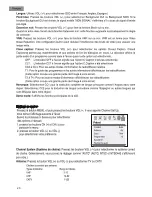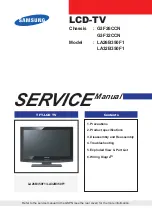
9
Getting started
USB 1
USB 2
(WLAN
)
HDMI 4
(2)
Brightness
sensor
(
-
page 24)
12
14
15
13
TV front view
Right side view
1
7
8
9
10
11
6
2
3
4
5
Headphones
(Not supplied)
!
1
(Power on/Standby)
— Press to turn the TV
on/ standby (
-
page 13)�
pBb
2
(Programme position)
— When no menu
is on-screen, these buttons select the programme
position�(
-
pages 17, 19)�
U u
(MENU up/down)
— When a TV menu is
on-screen, these buttons function as up/down menu
navigation buttons (
-
page 15)�
2
3
– / +
(Volume)
— When no menu is on-screen,
these buttons adjust the volume level�
I i
(MENU left/right)
— When a TV menu is on-
screen, these buttons are used for left/right menu
navigation and to adjust settings (
-
page 15)�
MENU
4
— Press to access the TV menu
(
-
page 15)�
RETURN
— When a TV menu is on-screen, this
button will take you back to the previous menu (
-
page 16)�
o
5
(Input source selection)
— When no menu is
on-screen, this button selects the input source
(
-
page 30)�
OK
— When a TV menu is on-screen, this button
will make a selection or take you to the next available
menu layer (
-
page 15)�
SD card slot
6
— For use when inserting an SD
Memory Card (
-
page 55)�
USB 1 port
7
— For use when inserting a USB device
(movies: DivX
®
, photo: JPEG, music: MP3)
(
-
page 55)�
o
8
HDMI 4 (input terminal)
— High-Definition
Multimedia Interface input receives digital audio and
uncompressed digital video from an HDMI device
(
-
page 42)�
o
9
(2) (Video 2 input terminals)
— Standard
video and standard audio inputs (
-
page 41)�
D
11
(Headphone jack)
— For use with headphones�
USB 2 port
11
— Only for use when using WLAN
with Dual Band WLAN Adapter (
-
page 47)�
!
12
(Power LED)
— Power indicator (
-
page 13)�
4
13
(On Timer LED)
— On Timer Indicator (
-
page 29)�
14
(Programme Timer LED)
— Programme
Timer Indicator (
-
page 29)�
(Remote sensor)
15
— Point the remote control
toward this remote sensor (
-
page 8)�
Note:
When the Headphone jack is being used,
the sound from all speakers will be muted.










































